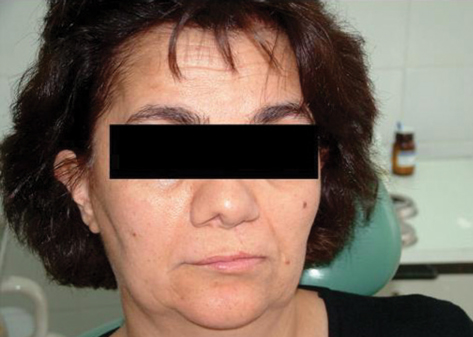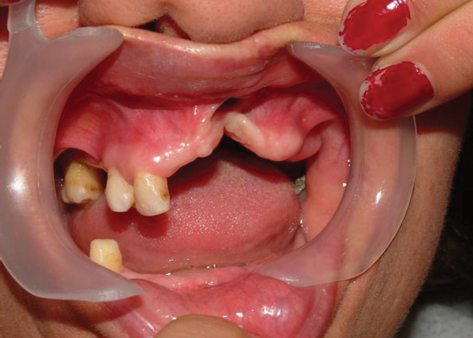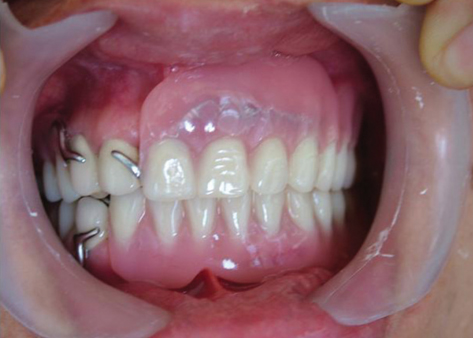J Korean Med Sci.
2008 Oct;23(5):924-927. 10.3346/jkms.2008.23.5.924.
Removable Partial Denture in a Cleft Lip and Palate Patient: A Case Report
- Affiliations
-
- 1Department of Prosthodontics Dental Faculty, the University of Dicle, Diyarbakir, Turkey. amese@dicle.edu.tr
- KMID: 1783087
- DOI: http://doi.org/10.3346/jkms.2008.23.5.924
Abstract
- This clinical report described the oral rehabilitation of a cleft lip and palate patient with removable partial denture. Although implant-supported fixed treatment was presented as part of the optimum treatment plan to achieve the best result, the patient declined this option due to the significant financial burden. Persons with a congenital or craniofacial defect are unique, and oral problems must be evaluated individually to the most ideal treatment. The changes in appearance, function, and psychological wellbeing have an enormous impact on patients' personal lives and are rewarding for the maxillofacial prosthodontist providing this care.
Keyword
MeSH Terms
Figure
Reference
-
1. Reisberg DJ. Prosthetic habilitation of patients with clefts. Clin Plast Surg. 2004. 31:353–360.
Article2. Saunders ID, Geary L, Fleming P, Gregg TA. A simplified feeding appliance for the infant with a cleft lip and palate. Quintessence Int. 1989. 20:907–910.3. Hochman N, Yaffe A, Brin I, Zilberman Y, Ehrlich J. Functional and esthetic rehabilitation of an adolescent cleft lip and palate patient. Quintessence Int. 1991. 22:401–404.4. Watanabe I, Kurtz KS, Watanabe E, Yamada M, Yoshida N, Miller AW. Multi-unit fixed partial denture for a bilateral cleft palate patient: a clinical report. J Oral Rehabil. 2005. 32:620–622.
Article5. Koyama S, Sasaki K, Inai T, Watanabe M. Effects of defect configuration, size, and remaining teeth on masticatory function in post-maxillectomy patients. J Oral Rehabil. 2005. 32:635–641.
Article6. Turner SR, Rumsey N, Sandy JR. Psychological aspects of cleft lip and palate. Eur J Orthod. 1998. 20:407–415.
Article7. Hickey AJ, Salter M. Prosthodontic and psychological factors in treating patients with congenital and craniofacial defects. J Prosthet Dent. 2006. 95:392–396.
Article8. Reisberg DJ. Dental and prosthodontic care for patients with cleft or craniofacial conditions. Cleft Palate Craniofac J. 2000. 37:534–537.
Article9. Goodacre CJ, Bernal G, Rungcharassaeng K, Kan JY. Clinical complications with implants and implant prostheses. J Prosthet Dent. 2003. 90:121–132.
Article10. Fukuda M, Takahashi T, Yamaguchi T, Kochi S, Inai T, Watanabe M, Echigo S. Dental rehabilitation using endosseous implants and orthognathic surgery in patients with cleft lip and palate: report of two cases. J Oral Rehabil. 2000. 27:546–551.
Article11. Diener E, Wolsic B, Fujita F. Physical attractiveness and subjective well-being. J Pers Soc Psychol. 1995. 69:120–129.
Article12. Harter S. The construction of the self: a developmental perspective. 1999. New York: Guilford Publications;315–343.13. Harter S. Suls J, Greenwald R, editors. Processes underlying the construction, maintenance and enhancement and self-concept in children. Psychological perspectives on the self: the self in social perspective. 1993. Hillsdale NJ: Lawrence Erlbaum Associates;137–181.14. MacGregor FC. Facial disfigurement: problems and management of social interaction and implications for mental health. Aesthetic Plast Surg. 1990. 14:249–257.15. Pope AW, Ward J. Factors associated with peer social competence in preadolescents with craniofacial anomalies. J Pediatr Psychol. 1997. 22:455–469.
Article16. Wiens J, Wiens R, Taylor T. Taylor TD, editor. Psychological management of the maxillofacial prosthetic patient. Clinical maxillofacial prosthetics. 2000. Chicago: Quintessence;1–13.
- Full Text Links
- Actions
-
Cited
- CITED
-
- Close
- Share
- Similar articles
-
- Prosthetic treatment for patient with congenital bilateral cleft lip and palate to close oro-nasal communication using maxillary double crown and clasp retained removable denture
- Treatment of the cleft lip and palate patient with few remaining posterior teeth using hybrid telescopic crown denture
- Removable implant-supported partial denture using milled bar with Locator(R) attachments in a cleft lip & palate patient: A clinical report
- Orthodontic consideration of cleft lip and palate (Report 1)
- Implant-assisted removable partial denture restoration in a partially edentulous patient with a single remaining tooth: a case report






